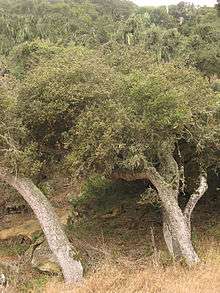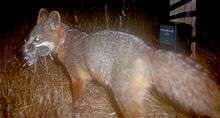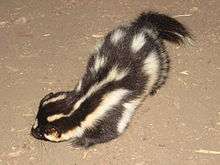Wildlife of the Channel Islands of California
The wildlife of the Channel Islands of California is wide and diverse, including many endemic species. While the land wildlife is slightly limited, there being only one large, naturally predatory, and native mammal, the small island fox, marine life can include anything from kelp forests to great white sharks.
Flora

Flora on the Channel Islands include a unique subspecies of pine, oak, and the island tree mallow. Santa Rosa Island holds two groves of the Torrey pine subspecies Pinus torreyana var. insularis, which is endemic to the island. Torrey pines are the United States' rarest pine species.[1] The islands also house many rare and endangered species of plants, including the island barberry, the island rushrose, and the Santa Cruz Island lace pod. Giant kelp forests surround the islands and act as a source of nutrition and protection for other animals.[2]
Invasive species, such as the Australian blue gum tree, olive tree, sweet fennel and Harding grass threaten native species through competition for light, nutrients, and water. The Australian blue gum, for example, releases toxins in its leaf litter which prevents other species of plants from growing in the soil surrounding it. The blue gum, as well as other species including the Harding grass, are much more flammable and better adapted to wildfires than native species.[3]
Kelp forests and many unique species of seaweed, sea urchin, and other marine plants live on the ocean floor.
Fauna

In the waters of the Channel Islands, sea lions are very common. Sharks like great whites, bulls, and tigers roam the seas. Orcas also appear near the Channel Islands.
The Channel Islands and the waters surrounding hold many endemic species of animals, including fauna such as the Channel Islands deer mouse, the Channel Islands spotted skunk, island scrub jay, ashy storm-petrel, Santa Cruz sheep, San Clemente loggerhead shrike, San Clemente sage sparrow. Many species of large marine mammals, including pacific gray whales, blue whales, humpback whales, and California sea lions breed or feed close to the Channel Islands. Current occurrences, if still happen, of the critically endangered North Pacific right whales, and historically abundant Steller's sea lions in these areas are unknown. Seabirds, including the western gulls, bald eagles, pigeon guillemonts, and Scripps's murrelets use the islands as well for shelter and breeding grounds. The endemic island fox is California's smallest natural canine and has rebounded from its near extinction in the late 1990s. Several endemic reptile species including the island fence lizard, island night lizard, and Channel Islands slender salamander live on the islands.[4]
Non-native species can include feral cows, sheep, and pigs.
Food Chain

The lowest on the food chain are the plants. Deer mice and small vermint follow, along with insects, lizards, and small birds, mammals and fish, like the spotted skunk.
The predatory animals include sharks, orcas(the apex predator), eagles, and foxes.
The island fox eats fruits, insects, birds, eggs, crabs, lizards, and small mammals, including deer mice.[5][6]
Land Mammals
Native
There are only three native land mammals on the archipelago: The island deer mouse, the island spotted skunk, and the island fox.
Deer mouse
The deer mouse exists on all eight islands. It can survive in conditions with a significant lack of fresh water, for example, Santa Barbara and Anacapa islands, the two Channel Islands without rivers.
Spotted skunk
The spotted skunk is only confirmed to exist on two islands: Santa Cruz Island and Santa Rosa Island. It used to be confirmed to exist on a third island, San Miguel Island, but is now presumed, but not confirmed, extinct. Santa Cruz Island houses a fair skunk number, but, however, Santa Rosa Island is home to over three thousand skunks.
Island fox
The island fox is the largest native land mammal, existing on six out of the eight Channel Islands: Santa Cruz, Santa Rosa, San Miguel, Santa Catalina, San Clemente, and San Nicholas. It does not exist on the Santa Barbara and Anacapa islands, though, due to the lack of fresh water.
References
- ↑ Conifer Specialist Group (1998). "Pinus torreyana var. torreyana". IUCN Red List of Threatened Species. Version 2006. International Union for Conservation of Nature. Retrieved 11 May 2006. Listed as endangered (EN C2b)
- ↑ "Kelp Forests – Channel Islands National Park (U.S. National Park Service)". Channel Islands National Park. U.S. National Park Service. Retrieved 9 May 2015.
- ↑ "Terrestrial Invasive – Channel Islands National Park (U.S. National Park Service)". Channel Islands National Park. U.S. National Park Service. Retrieved 9 May 2015.
- ↑ "Animals – Channel Islands National Park (U.S. National Park Service)". Channel Islands National Park. U.S. National Park Service. Retrieved 9 May 2015.
- ↑ Moore, C.M. and Collins, P.W. (1995). "Urocyon littoralis" (PDF) 489: 1–7.
- ↑ http://www.science.smith.edu/departments/Biology/VHAYSSEN/msi/pdf/i0076-3519-489-01-0001.pdf
